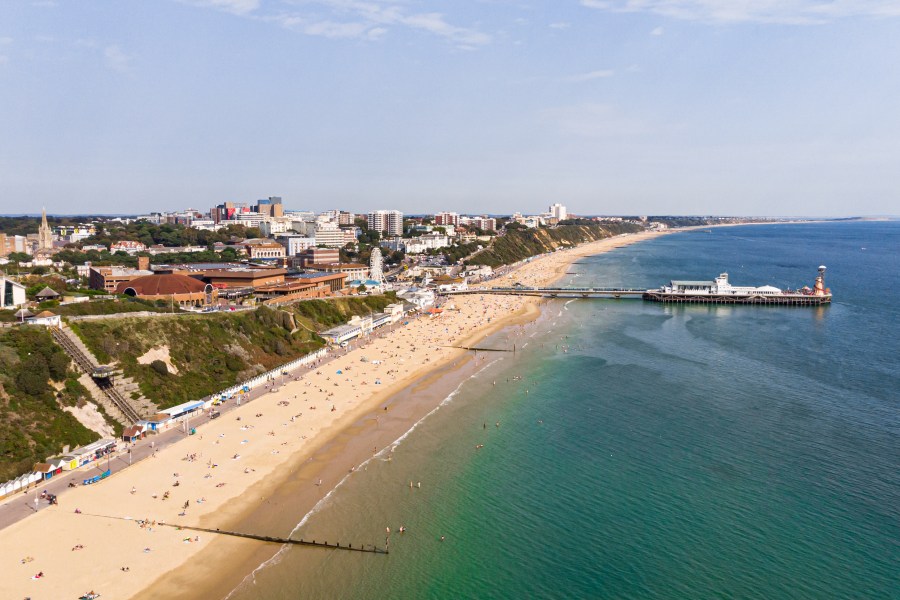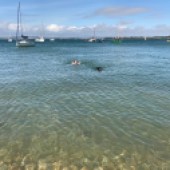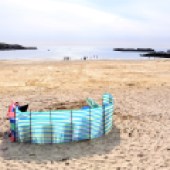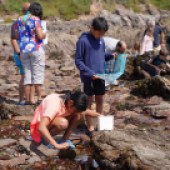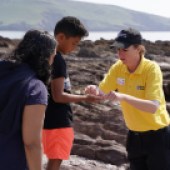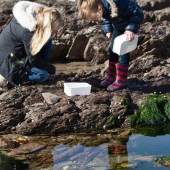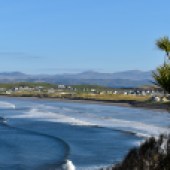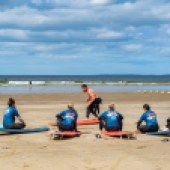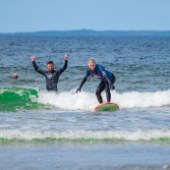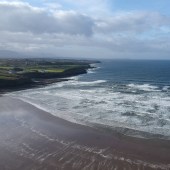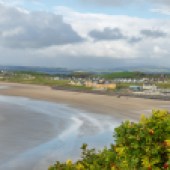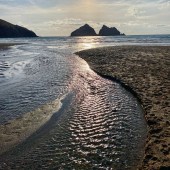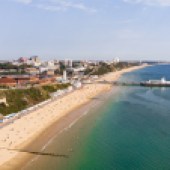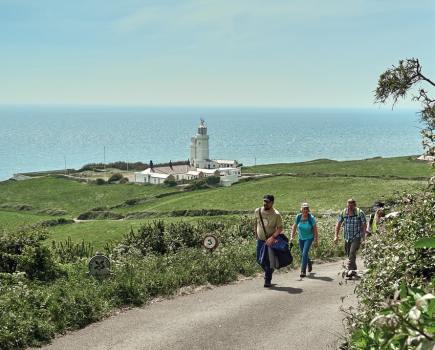So many beaches, so little time. Chrissy Harris rounds up some of the best of the best to make sure your summer trip to the coast suits your seaside needs.
BEST FOR…ROCKPOOLING
Wembury Beach, Devon
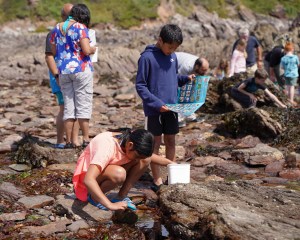
As seasoned rockpoolers, my family and I know that if the tide’s out, Wembury’s in. This National Trust-managed beach in south Devon has long been regarded as one of the best places in the country to see all the seashore favourites. Cushion starfish, worm pipefish, shrimp, blennies and the feisty velvet swimming crab are just a few of the regulars living in, under and around the rocky shoreline here in this special Marine Conservation Area.
You might also see more usual inhabitants. Wembury remains the setting for our top ever rockpool find so far – a squat lobster, discovered during one of the regular Seashore Safari events held here.
The expert team at Wembury Marine Centre organises regular events like this to help people learn more about the curious creatures that live around these parts (in the rockpools, that is).
There are also snorkel safaris and even night-time rockpooling sessions.
Stephen Hussey, from Devon Wildlife Trust, which runs the marine centre, says the events are a great way to get guided access to this special spot.
“Wembury is a narrow bay, but it has a really good complex of intertidal rockpools, which wraps around its eastern edge,” says Stephen. “Further out to sea, there are seaweed forests of kelp which act as a nursery to many fish species and other wildlife.”
All rockpoolers are encouraged to follow the Seashore Code (be safe, be kind and no nets).
ALSO VISIT
Dunraven Bay (Southerndown Beach), Wales. Rockpools as far as the eye can see at low tide. And keep your eyes peeled for inhabitants from another time. Dunraven Bay is also a hit with fossil hunters. See if you can find a Devil’s toenail, the fossil of an extinct oyster from the Triassic period.
West Runton beach, Norfolk. Norfolk’s only rockpools can be found around here in the Late Cretaceous chalk and flint deposits at the foot of the cliffs.
BEST FOR…DOG WALKING
West Wittering beach, West Sussex
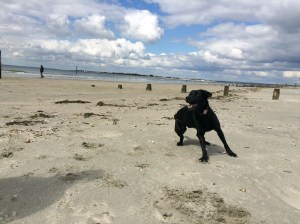
“It’s just lovely,” says Rachael Millar, owner of Millie the ten-year-old Labrador-cross. “We try and spend the whole day there when we go. Millie gets so excited. As soon as we get out of the car, that’s it, her whole body starts to wiggle because she knows what’s coming.”
A beautiful expanse of sand and shallow waters, natural salt marshes and dunes with fantastic views of Chichester Harbour and across the Solent to Isle of Wight – that’s what’s in store for Millie and co.
There are some restrictions in the main swimming areas during the summer but large stretches of the beach remain dog friendly.
“Millie loves everything about this beach – she’s like a puppy again,” says Rachael, who works for the Blue Cross animal welfare charity.
“She loves the sand between her toes, playing with her ball and going swimming. Sometimes I get in and go swimming with her. She does tend to look at me as if to say, ‘what are you doing?!’”
At the far end of the beach, you can walk around to East Head, managed by the National Trust (West Wittering beach is managed by the West Wittering Estate).
There are regular water taps dotted along the beach path for cleaning sand off humans and their pets, plus there are dog poo bins with dog waste bags dispensers.
Note: There’s a booking system in place for parking.
ALSO VISIT
Hengistbury Beach, Dorset. This scenic stretch of sand and pebble beach runs along the southern side of the headland. There’s lots to explore around here – coast, heathland, grassy meadows and more. Much work has been going on here to encourage dog owners to let their pets have fun, safe, off-lead walks while protecting the local wildlife. There’s a dog-walker trail, benches and signs.
Seacliff beach, East Lothian. A sweeping arc of golden sands with dunes, grassy banks and shallow waters. This is good for dog walks away from the crowds, plus there is potential for dolphin spotting.
BEST FOR…EATING
Sea Shanty Café, Trearddur Bay, Anglesey

Going to the beach is tiring and it’s important to refuel and rehydrate at regular intervals. A picnic will go only so far. The Sea Shanty Café in Trearddur Bay serves great food in a great location.
The original venue operated for more than 60 years before closing in 2002, leaving a noticeable gap in the market. In 2016, the cafe was relaunched by entrepreneur Phil Brown and has become a local success story. The seaside destination – which employs 13 chefs and has more than 92 staff on the books – serves an extensive menu, featuring plenty of seafood, as well as local classics, such as Welsh rarebit.
The food will keep you going while you take in the surroundings. The cafe has become famous for its collection of curiosities. Inside, there are (keep up, now) nine vintage wooden sailing boats, 14 vintage outboard motors, 270 bottles of sand from beaches all over the world, a large wooden clock, a mahogany Edwardian ice-cream parlour and a 100-year-old, fully restored jukebox which plays toe-tapping 1920s boogie tunes if you pop a pound coin into the slot. The money goes to local good causes.
ALSO VISIT
Riley’s Fish Shack, King Edward Bay, Tyne and Wear. This place does serious seaside grub. Named as one of the top beach shack restaurants in the UK, Riley’s serves seasonal fish sourced from the local day boats. Catches, including lobster and monkfish, are cooked over a charcoal barbecue.
Oban Seafood Hut (Green Shack), Argyll and Bute. A locally loved, family-run hut serving grab-and-go seafood, including lobster and other shellfish. Their sandwiches are famous – choose from crab, prawn or hot smoked salmon. There are also cold sharing platters, oysters, crab claws and tubs of mussels. Find a place on the bench and enjoy. It doesn’t get much better than this.
BEST FOR…YOUNG CHILDREN
Bournemouth beach, Dorset
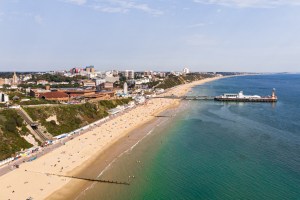
Sandy, safe and loads to see and do – this beach is parent paradise. When the sandcastles have been built, the beach ball has burst and there have been at least three tantrums (and that’s just the grown-ups), it’s just a short stroll to the town’s popular attractions. The Oceanarium, amusement arcades, plus ice-cream every ten paces will keep everyone happy during a fun filled day out.
“The beach is so accessible and safe for young kids,” says local mum Jessica Bain, who has two children, aged six and three. “We quite often pick the kids up from school and go there for a picnic and then some paddling and swimming. In fact, we’re having a beach party for my daughter’s birthday next week. We thank our lucky stars that we’ve got this right on our doorstep.”
To keep track of excited young beachgoers, a wristband safety scheme is in place across the area. Specially trained staff and seafront rangers hand out the free, colour-coded waterproof bands, allowing parents and carers to attach their contact number to their child. The colours relate to clearly marked sections of the seafront.
ALSO VISIT
Goodrington Sands, Devon. Boating lakes, a play park, amusement arcades, plus the occasional steam train passing overhead makes everyone feel like a kid again at this beach in Torbay. The water stays shallow for a long way, so it’s great for little swimmers.
Ventnor Beach, Isle of Wight. This family-friendly beach has the added benefit of its own paddling pool, complete with a model of the Isle of Wight in the centre. The kids will feel like giants while they splash around.
BEST FOR…SANDCASTLES
Robin Hood’s Bay, Yorkshire

As any decent builder will tell you, you’ve got to have the right materials for the job. This is especially important when it comes to constructing the perfect sandcastle. The fine-to-medium grain product available at Robin Hood’s Bay is ideal for working up that all-important consistency needed for a solid structure that doesn’t crumble too soon.
“It’s really good for building sandcastles there,” says expert Jamie Wardley. He’s part of the team at Sand in Your Eye, a group of artists who make sand sculptures and drawings across the UK.
Jamie says Robin Hood’s Bay has it all: good sand (which contains a little bit of mud for binding), beautiful views and plenty to do once the project is finished.
“I’ve got young kids and we like to build our sandcastles and then go and do a bit of rockpooling,” he says. “That’s what makes Robin Hood’s Bay special. And there’s an ice-cream truck.”
Spare a thought for the other parents trying to match Jamie and his family’s sandcastle creations, often constructed with a series of arches – a much admired architectural feature.
Jamie adds: “We usually end up with a whole troop of kids we don’t know and their parents all coming to help out.”
ALSO VISIT
Weston-Super-Mare beach, Somerset. For years, this seaside spot has hosted the World Sand Sculpture Academy, attracting artists from all over the world. The digging here is good, partly because there’s more sand than sea. There are also many beach front shops to get kitted out with the right equipment.
Talacre Beach, Flintshire. Miles and miles of the golden stuff, backed by dunes and great views across to the Wirral. It’s expansive and not too crowded, so take the opportunity to go big with your castle construction.
BEST FOR…SWIMMING
Holywell Bay, Cornwall
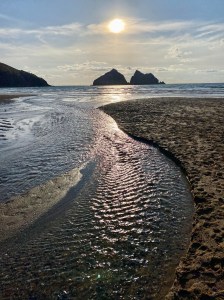
This wide, sandy beach is a Cornish classic and a top spot for taking a dip.
“It’s probably my favourite,” says Tom Mason, co-founder of Blue Balls Cornwall, a cold water swimming community for men. “It’s a nice, level beach, which makes it good for running along and then I tend to take a dip afterwards,” adds Tom. “There are some interesting rock formations in the sea and then you’ve got all the sand dunes– it’s just a lovely beach.”
Blue Balls held a group dip at Holywell last year as a way to encourage more men to experience the health benefits that cold water swimming can have on mental well-being.
“Around 10 to 30 people often come to our dips,” says Tom, who likes an early morning swim. “That’s my favourite time to go – it sets you up for the day.”
Lifeguards are on duty at Holywell Bay in the summer.
ALSO VISIT
Longsands beach, Tyne and Wear. The award-winning Tynemouth beach is clean, safe and enjoyed by swimmers all year round.
Achmelvich Beach, Sutherland. This is on the North Coast 500 route and can be accessed only by a single-track road. It’s worth the journey – stunning white-sand beach and dreamy aquamarine waters. Porpoises and dolphins and minke whales occasionally make an appearance.
BEST FOR…SURFING
Rossnowlagh beach, Donegal
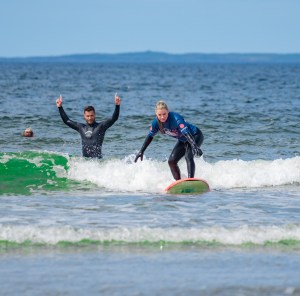
Rossnowlagh, along Ireland’s ‘Wild Atlantic Way’, is renowned as one of the best places in Europe to learn to surf. The seven-mile-long flat beach with its gentle gradient provides consistently good waves and breaks all year round.
James Garvey set up a surf school here nearly ten years ago with the help of a few like-minded friends because the location and the conditions were so ideal.
“I call it a cold-water Hawaii,” says James, who has been surfing all his life. “As the swell starts rolling in, it really is the perfect place for those long, rolling waves.
“I was with a group this morning and they were saying how beautiful it is here. They’d surfed in places like Portugal, France but they’d never seen anything like this beach.”
More advanced surfers can head along the coast towards Mullaghmore where there are, as James puts it, more ‘waves of consequence’, sometimes reaching 70ft.
“People come from all over the world to surf here in Donegal because we really do have it all here,” says James. “Just bring an umbrella!”
ALSO VISIT
Fistral Beach, Cornwall. We can’t talk about surfing beaches without mentioning Cornwall. This long-established surfing destination is as much about the culture as the waves. You can just go with the flow and soak up the atmosphere without getting your hair wet. And look out for the Cribbar Big Wave. This annual event created by a reef off the coast here attracts big waves surfers from across the world.
Freshwater West beach, Pembrokeshire. Experienced surfers love this south-westerly facing beach, said to have has the best waves in the county. Strong rip currents occur in these parts, however, so it’s no place for beginners.
Looking for some more fun on the coast? Head to the beaches section of our website to see what the UK coastline has to offer!

